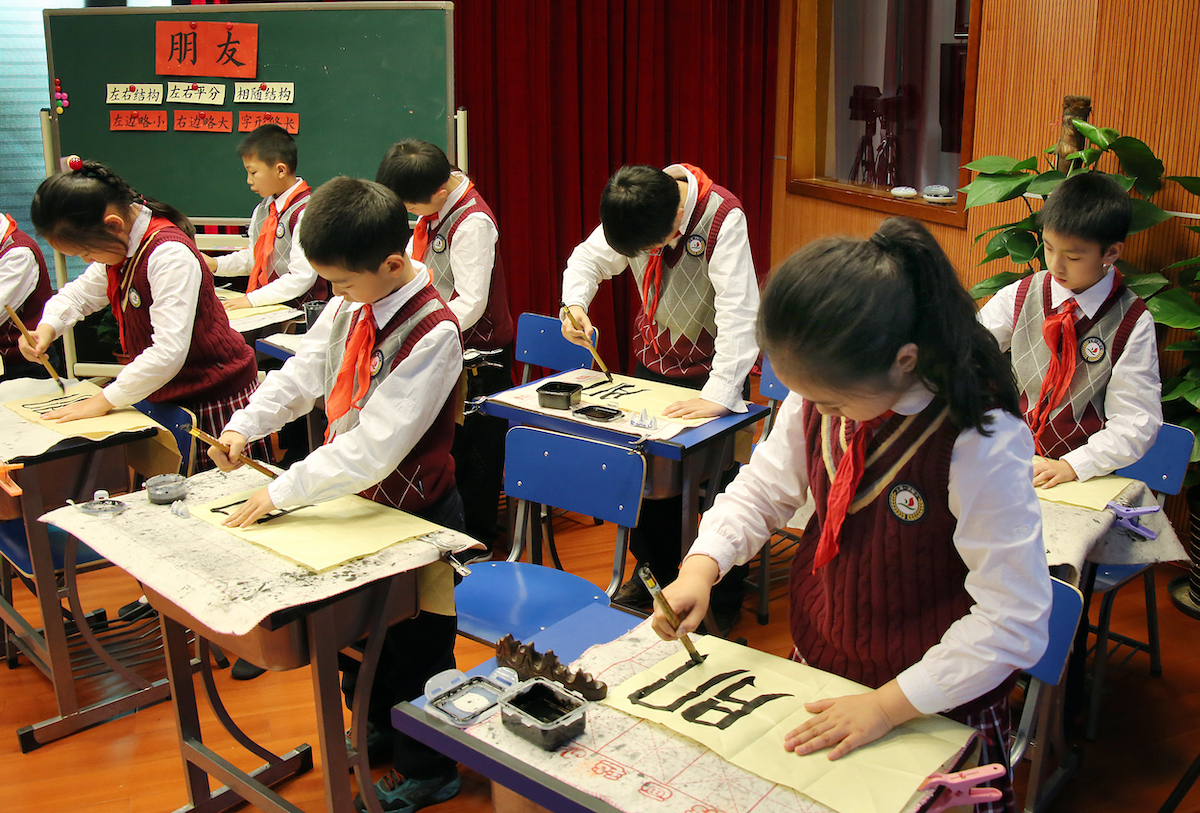In a recent essay for the New York Times, American fashion designer Heather Kaye writes about raising her daughters in Shanghai and sending them to the Chinese public schools. Far from finding the schools backward and totalitarian, she expresses profound gratitude for the experience: “As an American parent in China, I learned to appreciate the strong sense of shared values and of people connected as a nation.” She even goes so far as to consider the Chinese government schools her “co-parents,” since they played such an important role in raising her children.
While Kaye concedes that the Chinese government could be a bit pushy at times—particularly during the continual COVID lockdowns, which ultimately forced her family to move—she insists that the Chinese schools were a welcome alternative to their American counterparts, which held periodic live-shooter drills and had to deal with paranoid parents who bristled at the idea of any government institution acting as a co-parent. It was in China that her toddlers learned to work hard, push themselves academically, and adopt good manners, all of which enabled them to be “resilient, open-minded and independent” and excel in the American schools as teenagers.
Although Kaye’s story is instructive and fascinating, especially for American educators and parents, she unfortunately draws the wrong conclusions from it. She shamelessly credits the Chinese school system and Chinese government for her daughters’ education when she should really be praising Chinese culture, more specifically the Shanghai culture.
For anyone who has read Amy Chua, Amy Tan, or even Malcolm Gladwell, the Chinese generally place a heavy emphasis on education. As Chua explained in her notorious essay “Why Chinese Mothers Are Superior,” Chinese parents demand good grades from their kids and will push them hard to get those grades. Quoting a study on the topic, she points out a deep-seated belief among Chinese parents that “their children can be ‘the best’ students, that ‘academic achievement reflects successful parenting,’ and that if children did not excel at school, then there was “a problem” and parents “were not doing their job.” Whether out of love or pride (probably a mix of both), Chinese parents have few qualms about seeing their young children labor and struggle all hours of the day if it’s for school.
This prioritizing of academic achievement is amplified in urban elite centers like Shanghai where families compete aggressively to put their kids at the top of the class. From an early age, parents will bribe teachers, pay for tutors, and exploit every social connection they have to ensure that their child does well in school. If they’re successful, those children will reach the upper echelons of the Chinese government. Indeed, their behavior is not much different from that of aspiring elites in the U.S., something writer David Brooks notes in his rebuttal to Chua’s essay: “She does everything over-pressuring upper-middle-class parents are doing. She’s just hard core.”
Coupled with an academic culture is the specific demographic of China, where the older generations greatly outnumber the young. In a typical Chinese household, a child is lavished with attention by an array of grandparents, aunts, and uncles who, because of China’s disastrous one-child policy, are forced to invest all their hopes in him (or, less likely, her)—a bit like the society in the underrated movie Children of Men. Thus, it’s only normal that they all pitch in for the child’s upbringing and put pressure on him to be as successful as possible, so he can support his own parents when they retire.
Finally, Chinese pedagogy—that is, relentless drill-and-kill rote memorization and teacher-centered learning—is uniquely suited to young students. At this point in their cognitive development, it does little good to push advanced concepts and skills in place of establishing a firm foundation of retaining the basics. There’s also the important aspect of the Chinese language itself, which calls for readers to memorize pictographs (as opposed to phonemes) and introduces fundamental math concepts in its number designations. This is why Chinese children can give a specific number of how many words they know and why they tend to excel in math.
That being said, the composition of Shanghai classrooms in primary school is such that any style of teaching would be effective. Because the students and their families are so motivated, teachers are freed from the burdens of classroom management and differentiating material for kids with varying abilities. Instead, they can make extravagant demands on their students and assign hours upon hours of homework each week with little pushback. If American public school teachers tried anything close to this, they would be reprimanded and punished severely, if not fired altogether.
However, as the kids grow older, the American system, which itself is an adapted version of the liberal arts tradition, works better than the Chinese one. This is because American students are encouraged to learn more advanced skills of analysis, evaluation, and synthesis (otherwise known as higher-level thinking), whereas the Chinese students are still forced to double-down on rote memorization and direct application. This can be effective in subjects like math, but quickly becomes cumbersome in the other subjects. Consequently, most Chinese teenagers have to grit their teeth through the experience, desperately try to attend a university in the West or one of the handful of decent universities in China, and try not to burn out in the process.
All this is described at length in Lenora Chu’s excellent book Little Soldiers. Like Kaye, Chu lived in Shanghai and also made the decision to send her child to the local public schools. A writer by training, she’s able to articulate the instruction of her own child, who was enrolled in pre-K and kindergarten, as well as that of other students whom she interviews.
While Chu attests to the same positives of the Shanghai system, she’s also honest about the drawbacks. First, she’s willing to note the massive stress and frustration experienced by many Chinese high schoolers. If they haven’t succumbed to some form of screen addiction or given up entirely, they are huffing and puffing in an unforgiving rat race. Added to a ridiculous study load are the obligations to parrot idiotic CCP propaganda and do favors for various corrupt educational gatekeepers.
Second, the uncompromising rigidity and strictness can be outright brutal for students with even minor learning struggles. For example, Chu observes one kindergarten class where a student is called a litany of insults on an hourly basis. Shame is employed regularly for kids who fail to pick up an idea right away or are even slightly overweight. This becomes tragic for those kids who end up internalizing these criticisms and start identifying as fat, stupid losers with few prospects.
Third, and most importantly, the rigor and structure of Shanghai’s education system is an almost completely localized phenomenon. Outside the city, the quality of the schools drops precipitously, worse than anything one would find in even the worst American school district—which is the main reason why Shanghai and other big cities are separated from the rest of China on the PISA exam. Chu relates how many parents try to be zoned for Shanghai schools by any means necessary, since the alternatives are ramshackle one-room schools crammed behind sweatshops where a teacher rattles off a lesson for the few students in the front row who can listen while the rest of the class flounders helplessly.
Like the American school system—indeed, like any school system—the Chinese model has its strengths and weaknesses. Its main strengths are instilled by the culture: doing hard work, respecting teachers, and developing personal discipline. By contrast, its main weaknesses are instilled by the government: overwhelming pressure to conform, wildly disparate standards of quality, and a simplistic pedagogy that discourages advanced learning. Overall, this results in an industrious country with skyrocketing economic growth and rich cities, but also one with systemic oppression, impoverished rural areas, and little innovation.
In other words, what can be argued from Kaye’s experience is the exact opposite of what she posits in her essay: not more government involvement but more community involvement. Cultivating good study habits, moral behavior, and a healthy curiosity is something that primarily comes from cultural institutions like the family, neighbors, civic organizations, churches, and popular media. In most cases, a school can only reinforce what virtues already exist in the culture; it cannot create this out of nothing. The Chinese seem to understand this fact, but a growing number of Americans want to outsource all their responsibility to schools, only to become angry when they think the schools do too much (i.e., indoctrinate the students) or do too little (i.e., automatically pass them on).
Both the American and Chinese education systems would benefit from pedagogical reforms that reverse what they do with primary and secondary schooling: more rigor and drill in American elementary schools, and more freedom and critical thinking in Chinese high schools. Similarly, parents need to flip their attitude about public education: Americans can support their educators far more, and the Chinese can defer to their public schools far less. And if any of this really happens (one can always hope), it won’t be because of government benevolence but because people themselves are finally treating their children and public education system with the seriousness they deserve.

